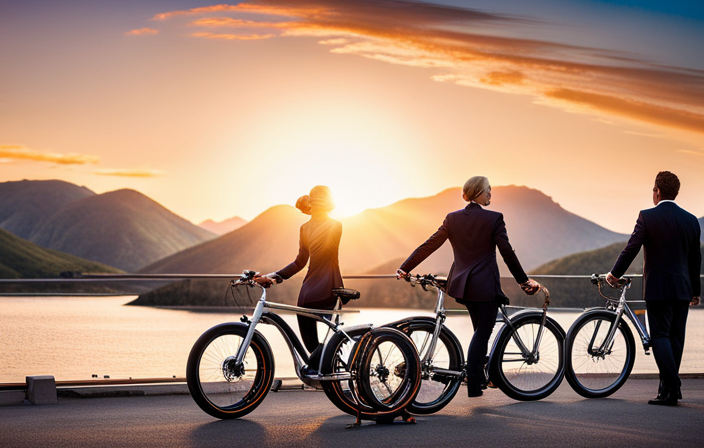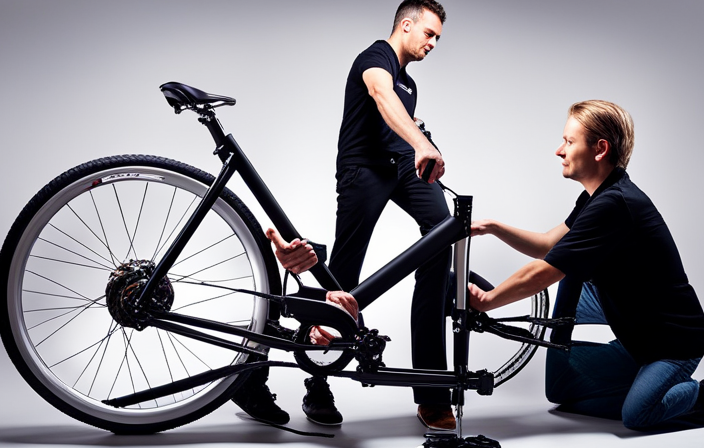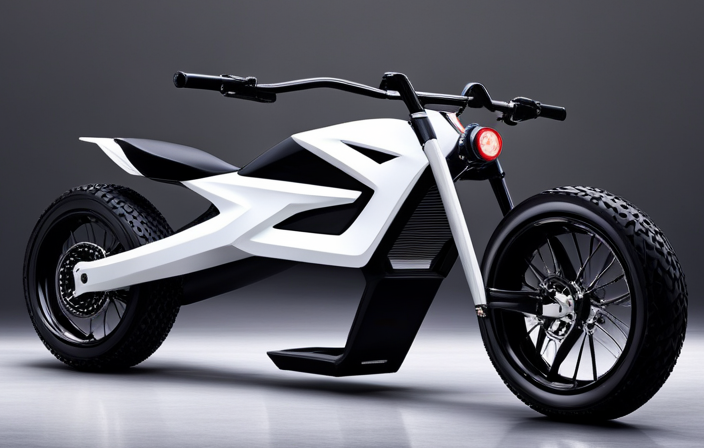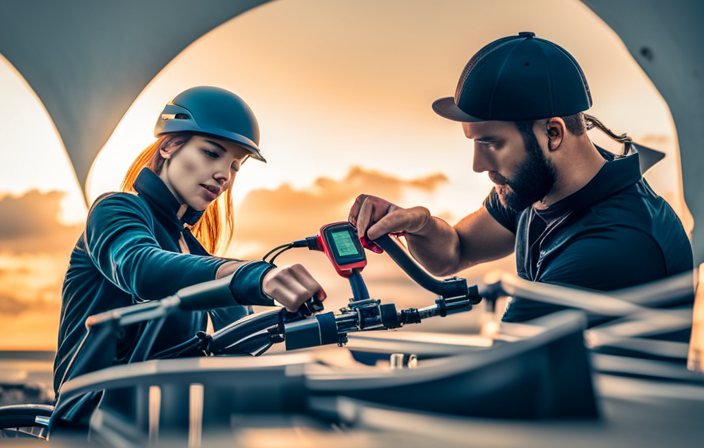Imagine the wind rushing through your hair as you effortlessly glide down the street, feeling a sense of freedom and independence.
Now, picture experiencing this exhilarating sensation despite having a disability.
Electric bikes have revolutionized the way individuals with disabilities can navigate the world, offering a newfound sense of mobility and joy.
In this article, I will explore the benefits, adaptations, and personal stories of disabled riders, as well as the safety considerations and resources available.
Join me on this exciting journey into the world of electric bikes for individuals with disabilities.
Key Takeaways
- Electric bikes provide a sense of joy and freedom to individuals with disabilities, allowing them to experience the joy of cycling and explore the outdoors.
- The motorized assist of electric bikes can be adjusted to match individual capabilities, making it easier for riders to conquer hills or ride longer distances.
- Customized adaptations and modifications, such as seat and handlebar adjustments, assistive devices, and wheelchair attachments, make electric bikes accessible to a wider range of individuals with disabilities.
- Safety considerations, including wearing helmets, checking brakes and tires, and being cautious in crowded areas, are crucial for disabled e-bike riders.
The Benefits of Electric Bikes for Individuals with Disabilities
You’ll love how electric bikes can greatly benefit individuals with disabilities. Electric bikes provide a fantastic opportunity for people with disabilities to experience the joy of cycling and explore the outdoors.
One of the biggest challenges for disabled riders is finding a mode of transportation that suits their needs and abilities. Electric bikes offer a solution by providing a motorized assist that can be adjusted to match individual capabilities. This means that riders can choose their level of assistance, making it easier to conquer hills or ride longer distances.
Additionally, electric bikes promote community support by allowing disabled individuals to join group rides and cycling events. The sense of belonging and camaraderie that comes from participating in these activities is invaluable.
Now, let’s dive into the next section and explore the adaptations and modifications available for disabled riders.
Adaptations and Modifications for Disabled Riders
When it comes to adapting electric bikes for disabled riders, there are several key modifications that can make a world of difference.
Customized seat and handlebar adjustments ensure a comfortable and ergonomic riding position, allowing for maximum control and stability.
Hand pedals and assistive devices provide additional support and power for riders with limited mobility, while wheelchair and mobility aid attachments allow individuals to bring their necessary equipment along for the ride.
These adaptations not only make electric bikes accessible to a wider range of individuals with disabilities, but they also promote inclusivity and independence, empowering riders to experience the joy and freedom of cycling.
Customized Seat and Handlebar Adjustments
The customized seat and handlebar adjustments make riding the electric bike a comfortable and personalized experience for disabled individuals. These adaptations are crucial in ensuring that riders with various disabilities can find the right position and support while riding.
The customized seat adjustments allow for individual preferences such as height, angle, and cushioning to be taken into account. This ensures that riders can ride for longer periods without discomfort or pain.
Additionally, the ergonomic handlebar modifications provide better grip and control, reducing strain on the hands and wrists. These adjustments are not only functional but also aesthetically pleasing, ensuring that disabled riders feel proud and confident while riding.
With these personalized modifications, disabled individuals can enjoy the freedom and thrill of riding an electric bike just like anyone else.
Transitioning into the next section, let’s explore the benefits of hand pedals and assistive devices for disabled riders.
Hand Pedals and Assistive Devices
Hand pedals and assistive devices provide additional support and functionality for riders with disabilities. With advancements in hand pedal technology, individuals with limited lower body mobility can enjoy the benefits of electric bikes. These alternative mobility options offer a sense of freedom and independence, allowing riders to explore the outdoors with ease.
Imagine gripping the specially designed hand pedals, feeling the power surge through your fingers as you effortlessly propel forward. The smooth, responsive controls make it a joy to navigate through various terrains, whether it’s a leisurely ride in the park or a thrilling adventure on rugged trails.
Additionally, assistive devices can be attached to the electric bike, further enhancing the riding experience for individuals with disabilities. These devices provide extra stability, ensuring a safe and comfortable journey.
Transitioning into the next section about wheelchair and mobility aid attachments, these innovative adaptations make electric bikes accessible to a wider range of individuals, revolutionizing the way we think about inclusive transportation.
Wheelchair and Mobility Aid Attachments
Imagine how convenient it would be to attach your wheelchair or mobility aid to an electric bike, allowing you to effortlessly navigate various terrains and explore the outdoors with ease.
Wheelchair attachments and mobility aid modifications have made this dream a reality for many disabled riders. With specially designed attachments, you can securely fasten your wheelchair to the bike, ensuring stability and safety throughout your ride. These attachments are versatile and can be easily adjusted to fit different types of wheelchairs and mobility aids.
Whether you want to go for a leisurely ride in the park or tackle rugged trails, these modifications enable you to enjoy the freedom and exhilaration of cycling. They provide a sense of independence and empower disabled individuals to experience the world in a whole new way.
Now, let’s explore some important safety considerations for disabled riders.
Safety Considerations for Disabled Riders
Riding an electric bike as a disabled rider comes with important safety considerations. As someone who has experienced the benefits and challenges of riding with a disability, I understand the importance of following safety tips and guidelines. Here are some key things to keep in mind:
- Always wear a helmet to protect your head in case of accidents.
- Make sure the bike is properly maintained and check the brakes and tires regularly.
- Be aware of your surroundings and use mirrors or other visibility aids to stay safe.
- Take extra caution when riding in busy or crowded areas, as it can be challenging to maneuver through traffic.
As a disabled e-bike rider, I have encountered numerous personal stories and experiences that highlight the freedom and joy that electric bikes can bring. These stories inspire me to continue exploring the world on two wheels, despite any challenges I may face.
Personal Stories and Experiences of Disabled E-Bike Riders
When it comes to riding an electric bike as a disabled individual, I know firsthand the challenges and barriers that can arise. However, I also know the incredible feeling of overcoming those obstacles and breaking through those barriers.
The journey of disabled e-bike riders like myself is not only inspiring, but it also opens up a whole new world of adventures and experiences.
What makes these journeys even more remarkable is the supportive community that we have built, where we encourage and uplift one another.
Overcoming Challenges and Breaking Barriers
To truly experience the freedom of riding an electric bike while disabled, you’ll need to overcome challenges and break barriers. Riding an electric bike opens up a world of possibilities, allowing us to defy limitations and embrace independence. Here are three reasons why breaking barriers and joining a supportive community is crucial:
-
Empowerment: Overcoming challenges on an electric bike empowers us to believe in our abilities and push beyond our perceived limitations. It gives us the confidence to take on new adventures and conquer the unknown.
-
Connection: Being part of a supportive community of disabled e-bike riders creates a sense of belonging. We can share our experiences, learn from one another, and build lasting friendships. It’s a reminder that we’re not alone in this journey.
-
Advocacy: By breaking barriers, we become advocates for inclusivity and accessibility. We inspire others to challenge societal norms and create a more inclusive world for disabled individuals.
Join me in the next section as we dive into the inspirational journeys and adventures that await us on our electric bikes.
Inspirational Journeys and Adventures
Exploring new horizons on an e-bike allows individuals with disabilities to embark on inspiring journeys and unforgettable adventures. It is truly remarkable to witness the inspiring achievements and empowering journeys of these individuals as they conquer challenges and break barriers. Riding an electric bike opens up a world of possibilities, enabling people with disabilities to experience the thrill of adventure and the joy of exploration. Whether it’s navigating scenic trails, conquering steep hills, or simply enjoying the freedom of the open road, an e-bike provides a unique opportunity for individuals to push their limits and discover the beauty of the world around them. These journeys not only inspire the riders themselves, but also inspire others to embrace their own passions and overcome their own obstacles. As we continue to explore the incredible stories of those who ride electric bikes, we are reminded of the importance of building a supportive community that uplifts and encourages one another on this journey of empowerment.
Building a Supportive Community
Building a supportive community is essential for individuals with disabilities to feel empowered and encouraged on their journey of exploration. By building relationships and fostering inclusion, we create an environment where everyone feels valued and supported.
When it comes to electric bike riding, having a community that understands the unique challenges and triumphs of disabled riders can make all the difference. Sharing experiences, tips, and encouragement with others who have similar experiences can help us overcome obstacles and achieve our goals.
Whether it’s through online forums, local meetups, or organized events, being part of a supportive community allows us to connect with others who share our passion for electric biking.
As we continue our discussion, let’s explore the various resources and organizations available for disabled e-bike riders, which can further enhance our journey of exploration.
Resources and Organizations for Disabled E-Bike Riders
As a disabled e-bike rider, I am always looking for resources and organizations that cater to my specific needs. That’s why I am excited to discuss three key resources that provide accessible options for disabled riders and create a sense of community and support.
Firstly, Disability-Friendly Bike Shops and Rentals are essential for disabled riders. These shops understand the unique needs of disabled cyclists and offer specialized services and equipment. They can help with bike modifications, repairs, and rentals, ensuring that disabled riders can enjoy the benefits of e-biking.
Secondly, Adaptive Cycling Programs and Events play a crucial role in providing opportunities for disabled riders to participate in cycling activities. These programs offer adaptive bikes and equipment, as well as trained staff who can assist riders with disabilities. Events such as group rides, races, and tours are also organized to foster a sense of community and inclusivity among disabled cyclists.
Lastly, Online Communities and Forums provide a platform for disabled riders to connect with others who share similar experiences and challenges. These communities offer a space for discussions, sharing tips and advice, and finding support. They can be a valuable resource for disabled e-bike riders to learn from others and feel a sense of belonging.
Whether you’re looking for a bike shop that understands your unique needs, a program that offers adaptive cycling opportunities, or an online forum to connect with other disabled riders, these resources are here to help you enjoy the freedom and joy of riding an e-bike.
Disability-Friendly Bike Shops and Rentals
When looking for disability-friendly bike shops and rentals, you can find places that cater to your specific needs. Here are three reasons why these disability-friendly bike shops and rental options are a game-changer for riders like me:
-
Knowledgeable staff: These bike shops have staff members who are trained in assisting disabled riders. They understand the unique challenges we face and can provide guidance on the best bikes and equipment for our needs.
-
Accessibility features: Disability-friendly bike shops are equipped with ramps, wide doorways, and accessible bathrooms, ensuring that everyone can easily enter and navigate the store. This inclusivity makes the experience more enjoyable for all.
-
Adaptive equipment options: These bike shops offer a wide range of adaptive equipment, such as handcycles, trikes, and electric bikes with modified controls. With these options, disabled riders can confidently explore the joys of cycling.
With disability-friendly bike shops and rental options, we can finally experience the thrill of riding with ease and confidence.
Now, let’s transition into the next section about adaptive cycling programs and events.
Adaptive Cycling Programs and Events
Get ready to explore new possibilities with adaptive cycling programs and events that cater to your specific needs and provide an inclusive and exhilarating experience.
These programs offer a range of adaptive cycling equipment, such as handcycles, recumbent trikes, and tandem bikes, that allow individuals with disabilities to enjoy the freedom and thrill of cycling.
Inclusive cycling programs are designed to ensure that everyone, regardless of their abilities, can participate and have fun. They provide expert guidance and support, helping you find the right equipment and adapt it to your individual needs.
Whether you’re a beginner or an experienced cyclist, these programs offer a variety of events, such as group rides and races, where you can challenge yourself and connect with fellow cyclists.
Joining these programs opens up a whole new world of possibilities and empowers you to push your limits and achieve your cycling goals.
As you embark on this exciting journey, you can also find additional support and connect with like-minded individuals through online communities and forums.
Online Communities and Forums
Explore online communities and forums where you can connect with others who share your passion for adaptive cycling and discover valuable resources and support. These online platforms provide a space for individuals with disabilities to come together, share their experiences, and learn from one another. Through online support, you can find advice on choosing the right electric bike for your needs, tips for modifications and adaptations, and even recommendations for accessible trails and routes.
Being a part of these communities allows you to connect with like-minded individuals who understand the unique challenges and joys of riding an electric bike with a disability. As we continue to advocate for inclusivity and accessibility, these online communities also serve as a platform to discuss future innovations and improvements for disabled e-bike riders, ensuring that our voices are heard and our needs are met.
Transitioning into the next section, let’s explore the exciting possibilities for the future of disabled e-bike riding.
Future Innovations and Improvements for Disabled E-Bike Riders
As a passionate advocate for inclusive cycling opportunities, I’m excited to discuss the future innovations and improvements for disabled e-bike riders.
One key point is the advancements in accessibility features, which aim to make e-bikes more user-friendly for individuals with disabilities.
Additionally, the integration of assistive technologies holds great potential in enhancing the riding experience and providing greater independence to disabled riders.
Lastly, the advocacy for inclusive cycling opportunities is crucial in ensuring that disabled individuals have equal access to the benefits and joys of cycling, promoting a more inclusive and diverse cycling community.
Advancements in Accessibility Features
Advancements in accessibility features have greatly improved the riding experience of disabled individuals on electric bikes. Now, even those with visual impairments can enjoy the thrill of riding with adaptations specifically designed for them.
These adaptations include tactile handlebars that provide feedback and guidance, as well as audio cues that alert riders to obstacles or changes in terrain. Additionally, the development of accessible e-bike trails ensures that disabled riders can explore the outdoors safely and independently. These trails are equipped with tactile markers and auditory signals, making it easier for visually impaired riders to navigate.
Furthermore, the integration of assistive technologies, such as voice-activated controls and GPS navigation systems, further enhances the accessibility of electric bikes for disabled individuals. With these advancements, disabled riders can experience the freedom and joy of riding an electric bike, breaking barriers and exploring new horizons.
Integration of Assistive Technologies
Don’t miss out on the convenience and accessibility that assistive technologies bring to your electric biking experience.
The integration of assistive technologies has revolutionized the way individuals with disabilities can enjoy the thrill of riding an electric bike. With the advancements in accessibility improvements, riders now have access to a range of features that enhance their biking experience.
From adaptive seating options to hand-controlled throttle and braking systems, assistive technologies have made it possible for individuals with disabilities to experience the freedom and independence of riding an electric bike.
These advancements not only provide a more inclusive riding experience but also encourage individuals with disabilities to embrace the joy of cycling.
As we delve into the next section about advocacy for inclusive cycling opportunities, we will explore the importance of creating a supportive and inclusive environment for all riders.
Advocacy for Inclusive Cycling Opportunities
Advocacy for inclusive cycling opportunities is essential in ensuring equal access and enjoyment for all individuals. Inclusive cycling programs are designed to provide accessible cycling equipment and opportunities for disabled individuals to participate in the joy of riding. These programs not only promote physical activity and well-being but also foster a sense of community and empowerment. By advocating for inclusive cycling, we can break down barriers and create a more inclusive society where everyone has the opportunity to experience the freedom and exhilaration of riding a bike.
To grab your attention, let me present a table showcasing the benefits of inclusive cycling programs:
| Benefits of Inclusive Cycling Programs | |
|---|---|
| Physical Fitness | Improved cardiovascular health and strength |
| Social Interaction | Opportunities to connect and engage with others |
| Independence | Increased self-confidence and autonomy |
| Mental Well-being | Reduced stress and improved overall mental health |
Join us in advocating for inclusive cycling opportunities and let’s pedal towards a more inclusive and accessible future for all.
Frequently Asked Questions
How much does an electric bike for individuals with disabilities typically cost?
An electric bike for individuals with disabilities, such as the elderly, can typically cost anywhere from $1,000 to $3,000. These bikes provide numerous benefits, including increased mobility, improved fitness, and a sense of freedom and independence.
Are there any specific weight restrictions for disabled riders when using an electric bike?
Are there weight restrictions for disabled riders on electric bikes? Safety measures should be taken into account when determining weight requirements to ensure a comfortable and secure riding experience for all individuals.
Can electric bikes for disabled riders be used off-road or on rough terrain?
Electric bikes for disabled riders can be used off-road or on rough terrain, but it’s important to take electric bike safety precautions. Look for the best electric bike brands for disabled riders that offer features like sturdy frames and reliable suspension for a smoother off-road experience.
What types of disabilities can benefit from using an electric bike?
Using an electric bike can benefit individuals with a range of physical disabilities, such as limited mobility or chronic pain. It provides physical exercise, boosts cardiovascular health, and enhances mental well-being, promoting a sense of freedom and independence.
Are there any limitations or restrictions on where disabled riders can ride their electric bikes?
There are some limitations and restrictions on where disabled riders can ride their electric bikes. It is important to consider accessibility concerns when choosing the right electric bike for disabled individuals.
Conclusion
After experiencing the joy and freedom of riding an electric bike as someone with a disability, I can confidently say that it has truly been life-changing.
The convenience and adaptability of electric bikes make them a game-changer for disabled individuals, allowing us to explore the world and reclaim our independence.
Through the support of organizations and the continuous innovation in accessible modifications, the future of disabled e-bike riding looks bright.
So let’s keep pedaling forward, embracing the possibilities and breaking down barriers together.
Together, we can redefine what it means to ride disabled.









